Embark on a fitness journey with exercise bands! These versatile tools offer a convenient way to enhance strength, flexibility, and overall fitness. Discover the benefits of incorporating resistance bands into your workout routine.
Benefits of Using Exercise Bands
Exercise bands offer a multitude of benefits, making them a valuable addition to any fitness regimen. Resistance bands provide dynamic tension throughout movements, increasing muscle fiber recruitment and control. This unique resistance enhances mobility and flexibility, allowing you to work from various angles.
Consistent use of exercise bands can improve posture, coordination, balance, and postural awareness. Muscle-strengthening exercises with bands can also reduce injury risk during daily activities and alleviate chronic pain. Their versatility allows for a full-body workout, targeting legs, arms, and core.
Bands are inexpensive and portable, making them ideal for home workouts or travel. They can simulate sports-specific exercises and be used by individuals of all fitness levels. Incorporating exercise bands promotes muscular strength and endurance, contributing to overall well-being and an active lifestyle.
Accessibility and Portability
One of the most significant advantages of exercise bands lies in their exceptional accessibility and portability. Unlike bulky gym equipment, resistance bands are lightweight and compact, making them incredibly easy to transport. Whether you’re traveling, working out at home, or heading to the park, exercise bands can easily fit into a gym bag or suitcase.
This portability ensures that you can maintain your fitness routine regardless of your location. Exercise bands are also highly accessible in terms of cost. Compared to expensive gym memberships or home gym setups, resistance bands are a budget-friendly option.
They are readily available at most sporting goods stores and online retailers, making them accessible to individuals of all income levels. This combination of portability and affordability makes exercise bands a practical and convenient choice for anyone seeking to improve their fitness.
Full Body Workout Potential
Exercise bands offer a remarkable potential for a full-body workout, targeting various muscle groups with equal effectiveness. From legs and glutes to chest, back, arms, and core, resistance bands can be incorporated into a wide range of exercises to stimulate muscle growth and improve overall strength.
The versatility of exercise bands allows you to perform exercises that mimic traditional weightlifting movements, such as squats, bicep curls, chest presses, and rows. By adjusting the resistance level of the band, you can progressively challenge your muscles and continue to see results over time.
Furthermore, exercise bands can be used to enhance bodyweight exercises, making them more challenging and effective. This full-body workout potential makes exercise bands an ideal tool for individuals seeking a comprehensive fitness solution.
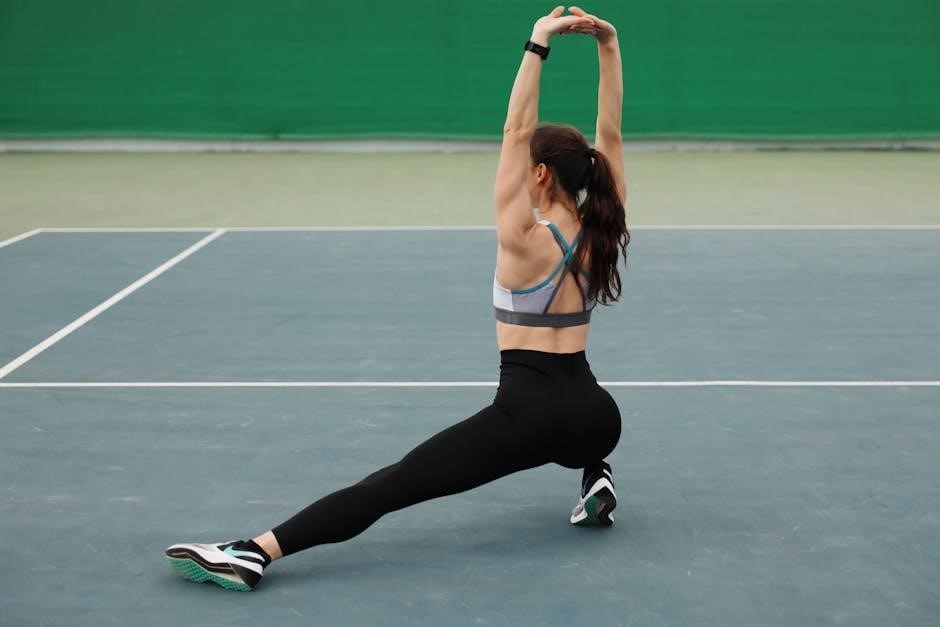
Understanding Resistance Bands
Delve into the world of resistance bands! Discover the various types, their unique features, and how to select the right band for your fitness level and goals. Unlock the potential of these versatile tools.
Types of Resistance Bands
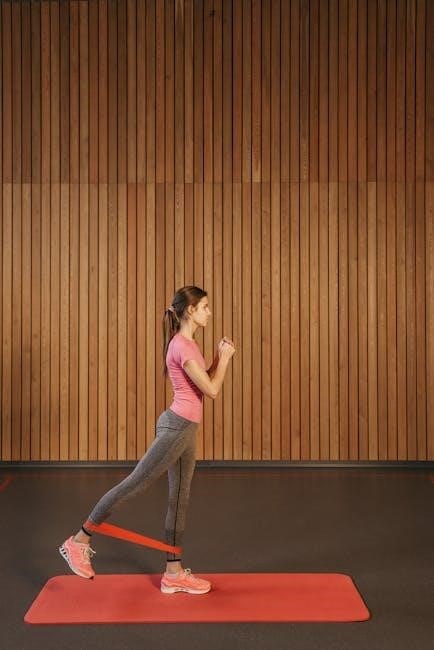
Resistance bands come in a variety of forms, each offering unique advantages for different exercises and fitness goals. Understanding the different types is crucial for selecting the right bands for your needs. Loop bands are continuous loops of rubber, ideal for lower body exercises and adding resistance to squats and lunges. Tube bands with handles provide a secure grip and are versatile for upper body exercises like bicep curls and chest presses. Physical therapy bands, often flat and wide, offer lighter resistance levels suitable for rehabilitation and gentle strengthening exercises. Power resistance bands are very resistant and are great for full-body exercise.
Each type caters to specific needs and preferences, impacting the effectiveness and comfort of your workouts. Consider the exercises you plan to perform and your current fitness level to make an informed choice. Experiment with different types to find the perfect fit for your individual requirements.
Loop Bands
Loop bands, also known as mini bands or resistance loops, are continuous, closed-loop elastic bands. Typically made of rubber or latex, they are available in various resistance levels, indicated by color-coding. These bands are incredibly versatile and are especially effective for lower body exercises. Their compact size makes them ideal for travel and home workouts.
Loop bands are commonly used to activate glutes and hip abductors, improving stability and preventing injuries. They can be incorporated into exercises like squats, lunges, and hip thrusts to increase the challenge and enhance muscle engagement. The constant tension provided by loop bands ensures that muscles are continuously working throughout the movement. This makes them a valuable tool for both beginners and advanced fitness enthusiasts. Loop bands are an affordable and effective way to add resistance and variety to your exercise routine.
Tube Bands with Handles
Tube bands with handles are a type of resistance band that features a rubber or latex tube with attached handles on each end. The handles provide a comfortable and secure grip, allowing for a wider range of exercises, particularly those that mimic traditional weightlifting movements. These bands are versatile and can be used to target various muscle groups, making them a great option for full-body workouts.
The handles allow for greater control and stability during exercises like bicep curls, chest presses, and rows. Tube bands with handles are available in different resistance levels, typically indicated by color. They can be easily anchored to doors or other sturdy objects, expanding the exercise possibilities. Their design makes them ideal for simulating gym exercises at home or while traveling. They offer a convenient and effective way to build strength and muscle.
Choosing the Right Resistance Level
Selecting the appropriate resistance level for your exercise band is crucial for effective and safe workouts. Resistance levels are typically indicated by color, with lighter colors offering less resistance and darker colors providing more. Beginners should start with lighter bands to master proper form and technique. As your strength increases, gradually progress to higher resistance levels to continue challenging your muscles.
The ideal resistance level allows you to perform the exercises with good form for the recommended number of repetitions. If you struggle to complete the reps or your form breaks down, the resistance is too high. Conversely, if the exercise feels too easy, it’s time to increase the resistance. Consider purchasing a set of bands with varying resistance levels to accommodate different exercises and fitness goals. Remember, consistent progress and proper form are key to achieving optimal results and preventing injuries.

Essential Exercise Band Exercises (PDF Guide)

Explore our essential exercise band exercises guide in PDF format! This comprehensive resource provides detailed instructions and illustrations to maximize your workouts and achieve fitness goals effectively.
Leg Exercises
Transform your lower body with resistance band leg exercises, a portable and effective way to build strength and tone muscles. These exercises offer constant tension, enhancing muscle fiber recruitment for better results. Incorporate squats, a fundamental movement, targeting quads, glutes, and hamstrings. Lying side leg raises isolate hip abductors, improving stability and posture. Hip bridge with pulse engages the glutes for enhanced definition.
Leg side abduction further strengthens hip muscles. Kneeling banded kickbacks sculpt the glutes with focused resistance. Single leg deadlifts challenge balance and hamstring strength. Explore kick butt extensions and jump squats for dynamic leg work. Perform three sets of 15-20 repetitions of each exercise. Remember proper form and gradual resistance increase. Use a mini band around your knees for some of the exercises to feel the burn!
These exercises promote functional movement, coordination, and postural awareness. Consistency can decrease the risk of injury when performing daily activities.
Squats
Elevate your squat routine with resistance bands! Stand on the band, feet shoulder-width apart, holding the ends. Maintain slight tension throughout the movement. Squats are a cornerstone exercise, targeting the quads, glutes, and hamstrings. Keep your chest lifted and abdominal muscles tight. Descend as if sitting into a chair, ensuring your knees track over your toes.
Use of the band adds resistance to the exercise. This increased resistance leads to more muscle recruitment and better results. Focus on maintaining proper form, keeping your back straight and core engaged. Avoid rounding your back or letting your knees cave inward; As you become stronger, increase the band resistance. You can also add variations like jump squats. Squats are an important part of a well-rounded workout plan.
This exercise promotes lower body strength, balance, and overall fitness. Consistently performing squats can improve your ability to perform everyday activities. Remember to breathe.
Lying Side Leg Raises
Target your outer thighs and hips with lying side leg raises using a resistance band. Secure a loop band around your ankles. Lie on your side with legs extended. Keep your bottom leg slightly bent for stability. Slowly raise your top leg against the band’s resistance. Focus on engaging your hip abductors.
Maintain a straight line from head to feet. Avoid rocking your body or using momentum. Control the movement as you lower your leg back down. Increase resistance of the band as you progress. Lying side leg raises improve hip stability and strengthen the gluteus medius. This exercise is crucial for hip joint health.
Adding this exercise to your routine will improve your balance and posture. Remember to breathe deeply throughout the exercise. If you experience any pain, stop immediately. These leg raises can be done anytime, anywhere. Consistency is key to seeing results.
Hip Bridge with Pulse
Elevate your glute workout with hip bridges with a pulse, enhanced by resistance bands. Start by lying on your back with knees bent and feet flat on the floor. Place a loop band around your thighs, just above your knees. Engage your core and glutes as you lift your hips off the ground, forming a straight line from shoulders to knees.
At the top of the bridge, perform a small, controlled pulse by squeezing your glutes and pushing your knees outward against the band’s resistance. Focus on maintaining constant tension in your glutes and thighs throughout the exercise. Slowly lower your hips back down to the starting position, maintaining control. Hip bridges with a pulse target the glutes, hamstrings, and hip abductors.
This exercise improves hip extension strength and stability. Remember to breathe deeply and maintain proper form throughout the movement. If you experience any discomfort, stop immediately. Include these hip bridges in your workout routine for a stronger, more toned lower body. These exercises can be modified for any fitness level.
Upper Body Exercises
Transform your upper body with resistance band exercises targeting every major muscle group. Resistance bands offer a versatile and effective way to build strength, tone muscles, and improve overall fitness. From chest presses to bicep curls, the possibilities are endless.
Engage your chest muscles with banded chest presses. Secure the band around your back and hold the ends in each hand, then push forward as if performing a bench press. Strengthen your biceps with bicep curls. Stand on the band and curl your hands towards your shoulders. Target your back muscles with resistance band rows. Sit with your legs extended, loop the band around your feet, and pull towards your torso.
These upper body exercises can be done anywhere, making them perfect for home workouts or travel. Remember to maintain proper form to prevent injury. Start with a lighter resistance and gradually increase as you gain strength. Incorporate these exercises into your routine for a stronger, more sculpted upper body. Resistance bands are free to collect from your local area, try resistance band exercises during TV adverts.
Bicep Curls
Sculpt your biceps with resistance band bicep curls, a fantastic exercise for building upper body strength and definition. This exercise targets the biceps brachii, the primary muscle responsible for flexing the elbow, leading to increased muscle mass and a more toned appearance. Resistance bands offer constant tension throughout the exercise, maximizing muscle fiber recruitment and promoting better results.
To perform bicep curls, stand on the resistance band with your feet shoulder-width apart, holding the ends of the band with your palms facing forward. Keep your elbows close to your sides and curl the band upwards towards your shoulders, squeezing your biceps at the top of the movement. Slowly lower the band back to the starting position, maintaining control throughout the exercise.
Adjust the resistance by stepping further onto the band for more intensity or easing off for less. Remember to maintain proper form and gradually increase the resistance as you get stronger. Incorporate resistance band bicep curls into your workout routine for sculpted biceps and a stronger upper body. This exercise can be done seated or standing.
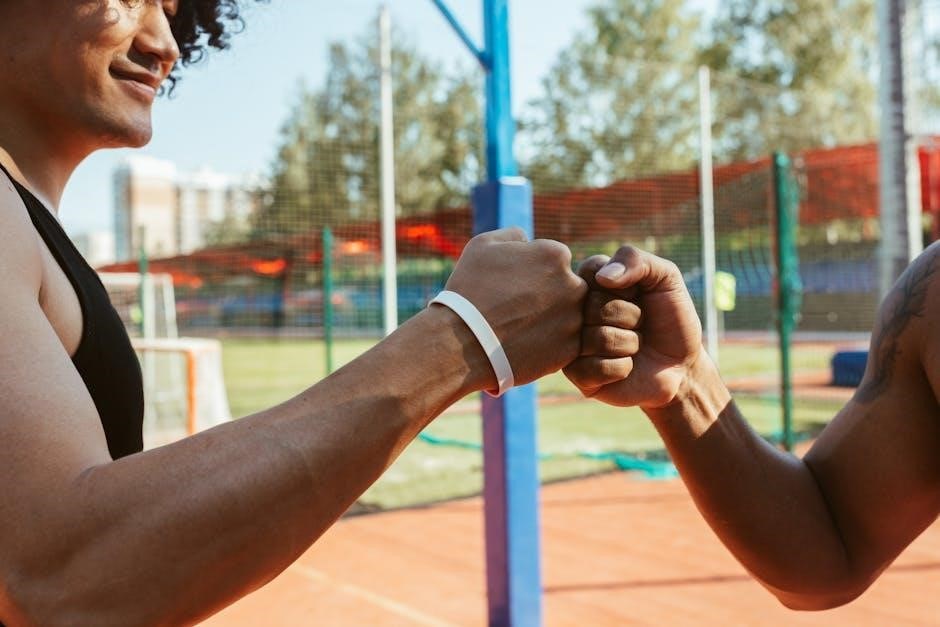
Chest Press

Target your chest muscles effectively with resistance band chest presses, a versatile exercise for building upper body strength. This exercise primarily works the pectoralis major and minor, the muscles responsible for pushing movements, leading to a stronger and more defined chest. Resistance bands provide constant tension throughout the exercise, maximizing muscle fiber activation for optimal results.
To perform resistance band chest presses, secure the band behind your back, holding the ends in each hand with your palms facing forward. Step forward to create tension in the band, and then press your hands forward, extending your arms fully. Slowly return your hands to the starting position, maintaining control throughout the movement.
Adjust the resistance by stepping further away from the anchor point for more intensity or closer for less. Remember to maintain proper form and gradually increase the resistance as you get stronger. Resistance band chest presses are a great way to build a stronger chest without weights. Incorporate this exercise into your workout routine for a more powerful upper body.
Back Rows
Strengthen your back muscles with resistance band back rows, an effective exercise that targets the lats, rhomboids, and trapezius muscles. Back rows enhance posture, improve upper body strength, and contribute to a well-rounded physique. Resistance bands provide constant tension throughout the exercise, promoting greater muscle activation and growth.
To perform resistance band back rows, sit on the floor with your legs extended in front of you. Place the center of the resistance band around your feet, holding the ends in each hand with your palms facing each other. Keep your back straight and core engaged, pull the band towards your torso, squeezing your shoulder blades together. Slowly return your hands to the starting position, maintaining control throughout the movement.

Adjust the resistance by moving your feet closer to your body for more intensity or further away for less; Remember to maintain proper form and gradually increase the resistance as you get stronger. Resistance band back rows are a great way to build a stronger back without weights. Incorporate this exercise into your workout routine for a more powerful upper body.
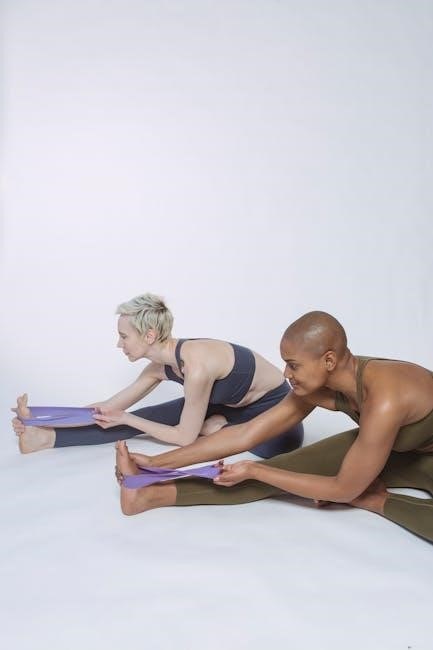
Safety and Technique
Prioritize safety and proper technique when exercising with resistance bands. Correct form and posture are crucial to prevent injuries and maximize results. Learn essential anchoring techniques and always warm-up and cool-down before and after workouts.
Proper Form and Posture
Maintaining proper form and posture is paramount when performing resistance band exercises. It ensures that you target the intended muscle groups effectively and minimizes the risk of injury. Before starting any exercise, take a moment to assess your body alignment. Keep your core engaged by gently drawing your navel towards your spine. This helps stabilize your torso and protect your lower back.
Pay attention to your spine, ensuring it maintains its natural curves. Avoid rounding your back or arching excessively. Your shoulders should be relaxed and pulled slightly back, not hunched forward. When performing exercises that involve bending over, hinge at your hips while keeping your back straight. Throughout each movement, maintain a controlled and steady pace, avoiding jerky or rushed motions.
Focus on the muscles you are working, feeling the resistance of the band as you contract and extend. If you are unsure about your form, consider consulting with a fitness professional who can provide personalized guidance and feedback. Remember, quality over quantity is crucial when it comes to resistance band exercises.
Anchoring Techniques
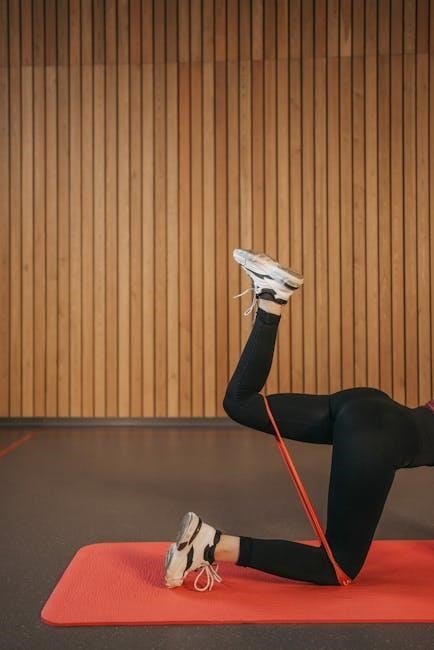
Proper anchoring is essential for many resistance band exercises, providing a stable point of resistance. Several methods can be used, depending on the exercise and available equipment. A common technique involves using a door anchor, a strap with a soft padded end that secures the band in a doorway. Place the anchor at the desired height, ensuring the door closes firmly towards you.
Alternatively, you can loop the band around a sturdy, immovable object like a pole or tree, ensuring it’s free from sharp edges that could damage the band. For some exercises, your own body can act as an anchor. For example, you can stand on the band to create resistance for bicep curls.
Always inspect your anchor point before starting your workout to ensure it’s secure and won’t move during the exercise. Test the resistance by gently pulling on the band before fully committing to the movement. Avoid anchoring the band to unstable objects or areas that could pose a safety risk. Experiment with different anchoring techniques to find what works best for each exercise.
Warm-up and Cool-down
Prioritizing a proper warm-up and cool-down is crucial when working with resistance bands, just as with any other exercise routine. A warm-up prepares your muscles for the workout ahead, increasing blood flow and flexibility. This helps to prevent injuries and improve performance. A dynamic warm-up, involving movements that mimic the exercises you’ll be performing, is particularly effective.
Include exercises like arm circles, leg swings, and torso twists to activate the relevant muscle groups. Perform each movement for 10-15 repetitions.
Following your workout, a cool-down helps your body gradually return to its resting state. It reduces muscle soreness and improves flexibility. Static stretching, holding each stretch for 20-30 seconds, is ideal for a cool-down. Focus on stretching the muscles you worked during the exercise band routine, such as hamstrings, quadriceps, chest, and back. Remember to breathe deeply throughout your warm-up and cool-down to enhance relaxation and recovery. Skipping these steps can increase your risk of injury and hinder your progress.
